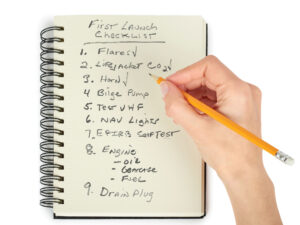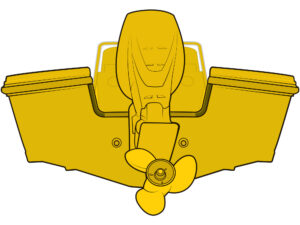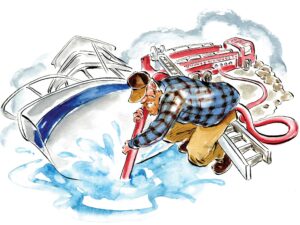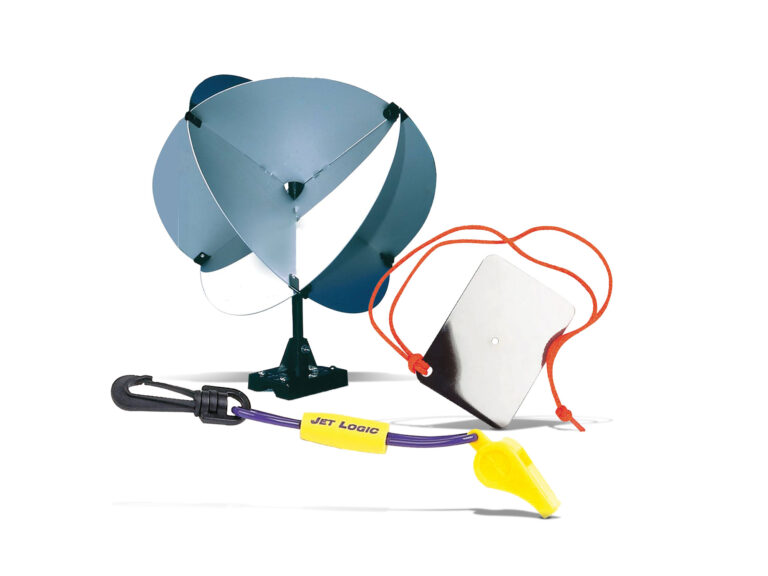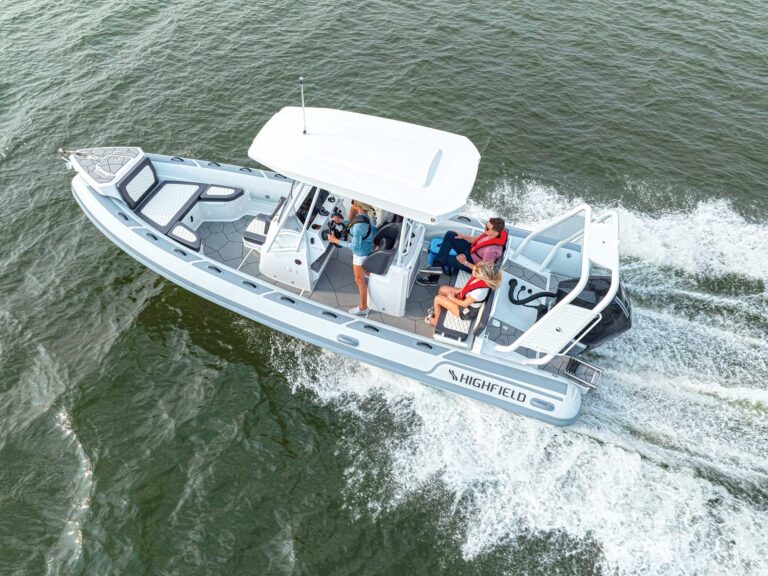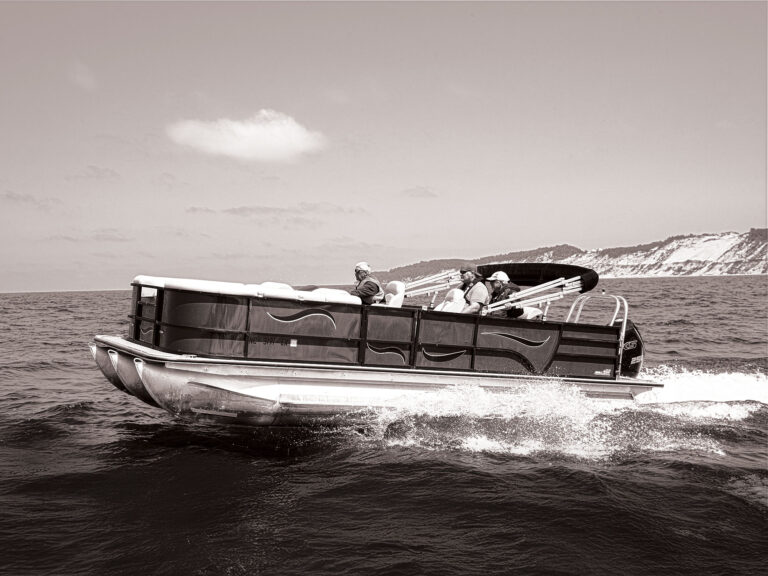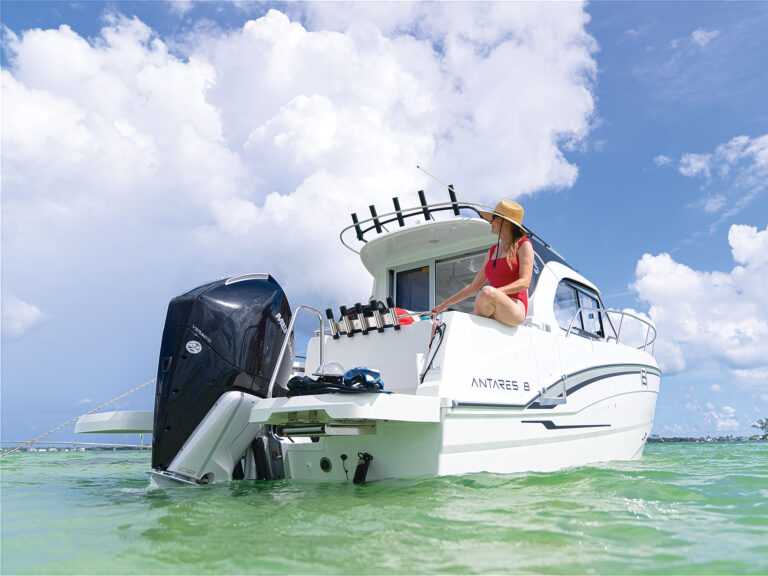Your dot-coms have turned into dot-bombs, and your portfolio has dropped like a 40-pound Danforth-chain, rode, and all. In this bear market, Alan Greenspan makes more TV appearances than Jennifer Lopez, layoffs are everywhere, and fuel prices have gone through the T-top. But that doesn’t mean you have to give up on your boat.
To get you through these tough times we’ve come up with 55 money-saving tips. So get out there and have fun. We bet you’ll barely notice that you’re saving money at the same time.
Running on Empty
1. Jackrabbit starts save fuel. The School of Transportation and Society in Sweden found that if you throttle up to two-thirds of maximum capacity as soon as possible, a gas engine pumps the optimum mix of fuel and air into the cylinders. Studies have shown a fuel savings of up to 15 percent.
2. Run your gas engine at 3000 to 3500 rpm and your diesel at three-quarters throttle. Listen to the point where the engine runs with the least vibration and strain once on plane. That’s your “sweet spot.”
3. If you rarely exceed three-quarters throttle on your Detroit Diesel, install smaller injectors to save fuel. On a pair of 8V-92s, installation should take about 10 hours plus the cost of injectors.
4. Keep a minimum of gear onboard, only bringing what you need. The same goes for fuel. Don’t fill up unless you’re planning a long trip. Both save weight, which increases your mpg.
5. Get a synchronizer (about $290 and up) for your twin screw boat so one engine doesn’t hold back the other and uselessly burn fuel.
6. Use an autopilot (about $900 and up) to keep an accurate course. For each degree off course, you will be about 100′ to one side of your track after a mile. On long runs, an autopilot can provide major fuel savings.
7. Boat in salt water. For every foot of draft in fresh water, your boat will rise about 1/4″ in salt water. The less boat in the water, the less drag, and the more fuel you will save.
8. Install a hydrofoil (about $30) on your outboard’s or stern drive’s lower unit so you can cruise at a slower speed and save money. On boats under 22′, a hydrofoil might let you stay on plane 2 to 5 mph slower than before.
9. Buy fuel at the local gas station instead of the marina and you may save 30 to 50 cents per gallon. Haul it to your boat in a Gas Caddy or Fuel Mate (about $200). You’ll be able to wheel almost 30 lower-price gallons down to your boat.
Wheeling and Dealing
10. Look for boats that have been languishing in the showroom. On the average, dealers finance their inventory for about six months. Beyond that, the boat is a prime candidate for a good deal.
11. Can’t get a bargain on a boat that’s in stock and don’t mind waiting six to eight weeks? Ask the salesperson about the builder’s discount policy for cash on a new boat.
12. Can you overlook a new boat’s popularity? Dealers are often encouraged to take less-popular models as part of a new-model-year discount. You might be able to get one of these at a bargain price.
13. Shop at the end of the month. That’s when salespeople begin to worry about meeting their quotas.
14. The “new” boat you buy in July is already a year old, as most of the next year’s models come out in August. Why not ask the salesperson to adjust the price accordingly?
15. Are leftovers really bargains? With low inflation rates, it’s likely that the difference between what your dealer paid for last year’s model and this year’s isn’t all that much.
16. If you trade up often, or don’t plan on owning a new boat for more than a couple years, a lower bottom line price may be a better deal than lower interest payments.
17. If you plan to own a new boat for the full term of the loan, the offer with lower rates and a higher price may be a better deal than the boat being sold at a lower price with higher rates.
18. Take out a home equity loan. Rates are low. You can deduct mortgage interest and you have more available cash for other investments.
19. When should you refinance your long-term boat loan? A rule of thumb is that the new rate should be at least two points lower than your current rate to make it worthwhile.
20. If you can, buy and register your boat in Alaska, Delaware, Montana, New Hampshire, or Oregon, where you don’t have to pay sales tax. Colorado is also a good deal at 2.9 percent.
Got Coverage?
21. Bluewater cruisers should call their insurance agents every time they intend to spend a month or more in new waters. Rates often vary from state to state and for the time of year.
22. Is it worth taking a high insurance deductible? Yes, if you can recover the deductible in premium savings within three years.
23. Mercury has an insurance program called Boater’s Choice. It offers a 25 percent premium reduction the first year, 20 percent the second, 15 the third, 10 the fourth, and 5 the fifth.
24. If you have your life, auto, and health insurance with one company, buy your boat insurance through the same carrier and get a multiple line discount of 10 to 15 percent.
25. Save with a million-dollar umbrella liability policy. You keep less individual liability coverage on your car, boat, and home; make up for-or increase-it with a $100-to-$200 overall policy.
26. As an alternative, if you live in a climate with cold winters, inquire about seasonal liability insurance coverage for your boat. You don’t boat year-round, why should you pay for a year’s worth of insurance?
Tax Breaks
27. If your boat has been your primary residence for two of the last five years, the IRS says that the first $450,000 of gains from selling your boat for individuals, or $500,000 for couples, does not count as part of your income. Plus there is no longer a reinvestment requirement.
28. The IRS defines a second home as having “basic living accommodations such as a sleeping space, toilet, and cooking facilities.” If you “summer” on a boat that has these, your loan may be tax deductible.
29. If you used your home to secure an equity loan to buy a boat, that interest should be deductible regardless of what type of boat or its accommodations.
30. Can tournament fishing qualify as a legitimate business? Yes, if you reel in more prize money than you spend competing for three out of every five years. If so, your expenses are deductible.
31. Your boat qualifies as a “for profit” business from which you can deduct expenses if you use it for business entertainment, whether you’re self-employed or work for a company that does not reimburse you.
32. If you use your boat at least 20 percent of the time for charters, it’s a legitimate business. If some equipment, such as a fishfinder, is strictly for charter use, you can deduct 100 percent of its cost.
Storage Options
33. Rack storing versus slipping your boat can save money. The difference can range from $3 to $21 per foot, depending on location.
34. Rent a slip behind someone’s house. You can often save about a third off the slip rate at local marinas.
35. Offer to pay your yard bill in advance and ask for an early-pay discount, which can usually save you at least 10 percent.
36. Get a season pass for the launch ramp. It will save you up to 10 percent compared to the total cost of paying each time.
Roll Up Your Sleeves
37. Save the door and zipper from the winter shrink-wrap. Though marinas don’t always advertise it, these are reusable and can save you $20 or more.
38. Invest in a dipstick pump (about $26) for oil changes. It will pay for itself in two years or less.
39. Tune up your engine when you have it winterized in the fall and save an hour’s worth of the mechanic’s time-and fee.
40. Learn to do a tune-up and the winterizing yourself; pay only for the parts. Winterizing an outboard costs about $175 at the yard, while a boat with twin diesels, two heads, air conditioning, and a genset can run up to $3,500.
41. Should you apply a multiseason bottom paint? Let’s do the math. Interlux Micron Extra lasts two seasons in the Northeast and goes for $170 a gallon. Interlux BottomKote single-season paint is $100 a gallon. You save $30 on the paint, plus labor.
42. Buy outboard oil in bulk. Use your own container and save $5 per gallon.
Reeling in the Cash
43. Buy your ice where commercial fishermen do. It’s the only place you’re sure to find big blocks rather than the faster-melting small cubes.
44. Don’t buy bait, catch it. Invest in a cast net ($30 to $50, depending on size) for shallow water baits, and Sabiki rigs ($3 to $5) for deep-water baits.
45. Eat what you catch. A 30-pound tuna nets about 15 pounds of steaks. That’s 30 individual main courses that you don’t have to buy at the supermarket.
46. Make your own lures. On average, saltwater flies cost $2 to $5 apiece and bucktail jigs run about $2 each. You can buy 100 hooks for $8 and get the bulk materials you need to make 100 flies and jigs starting at about $10.
Wise Spending
47. If you troll with a high-power carbureted two-stroke outboard that is inefficient at low speeds, install a small kicker motor and save on gas-and have backup power to boot.
48. Get into a discount program from BoatU.S. and get a 3 percent rebate on everything you buy. West Marine has a similar program, or you can use your AAA card to get a 10 percent discount at NAPA stores, which have marine engine accessories.
49. Should you use household instead of marine supplies? Sometimes. Fantastik cleaner ($3/32 oz.) is actually recommended by one manufacturer for cleaning vinyl, and baby oil ($2/20 oz.) is viable vinyl treatment.
50. Check out garage sales. Where else can you find everything from cheap fishing tackle to waterskis at deep discounts?
51. Multifunction electronics are less expensive. A Furuno GP1650F GPS/ Chartplotter/Fishfinder sells for $1,700. A Furuno FCV600L Fish-finder costs $900, and a GP1650 GPS/Chartplotter is $1,540. You also save on installation.
52. Don’t buy bottled water. Fill up plastic jugs with tap water filtered by Brita or PUR filter pitchers.
53. Install Bearing Buddy wheel bearing lubricators ($17 to $21) on your trailer hubs and extend your wheel bearing life.
54. The most expensive way to cook is with electricity. The least expensive and most efficient fuel is propane. Combine that with an old-fashioned pressure cooker and your cooking fuel costs will be almost nil.
55. Charts are expensive. Buy black-and-white copies of the latest charts for less than half what NOAA charges from Bellingham Charts at 800/643-3900.

